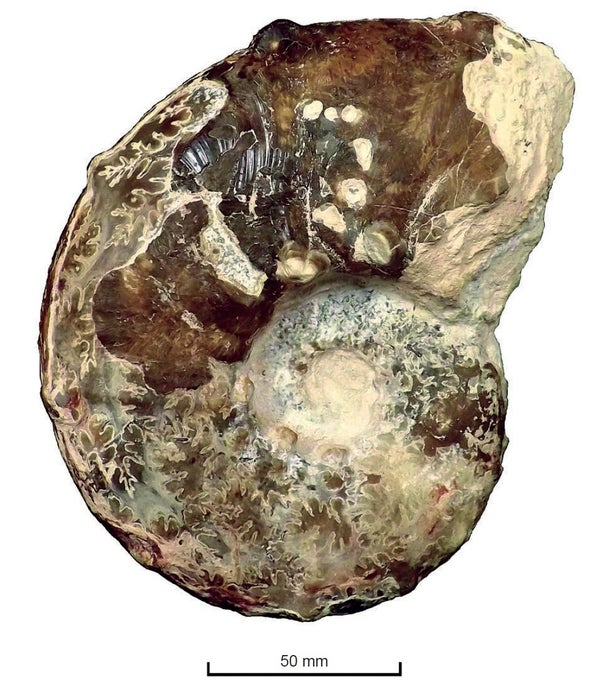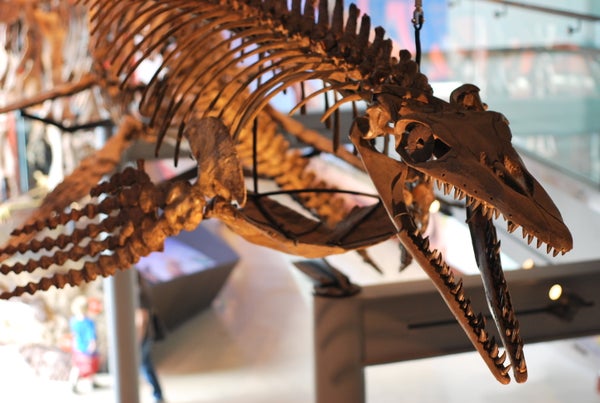This article was published in Scientific American’s former blog network and reflects the views of the author, not necessarily those of Scientific American
On supporting science journalism
If you're enjoying this article, consider supporting our award-winning journalism by subscribing. By purchasing a subscription you are helping to ensure the future of impactful stories about the discoveries and ideas shaping our world today.
Who ate whom? This is one of the most persistent questions of the fossil record, and teeth only get us part of the way there. Serrated fangs would suggest a more carnivorous diet than rows of flat molars, for example, but even then we’re still left with the conundrum of what an animal could eat and what it actually consumed. That’s why fossil leftovers are highly prized, be they tooth-scraped bones, gut contents, or, in the case of a particular fossil from Morocco, a perforated shell.
The fossil, described by paleontologist Andrew Gale and colleagues, is one of the spiral-shelled cephalopods experts know as ammonites. In particular, this was a young Pseudaspidoceras. Others of its kind have been found before, but two intertwined facts make this specimen stand out. Not only do punctures pock the surface of the shell – signs of assault by a marine reptile – but, at over 90 million years old, the damaged ammonite is one of the oldest of its kind.
Paleontologists are familiar with the damage pattern. Dozens of ammonite shells from the Cretaceous rock of North America have been found with holes made by the bites of mosasaurs – large, predatory marine lizards. But other marine predators, including fish, could have left their mark on ammonites, too. Best to check so as not to implicate the wrong culprit.

The left side of the bitten Pseudaspidoceras. Credit: Gale et al 2017
The Pseudaspidoceras shell is marked by six holes in a U-shaped pattern on the left side and three irregular punctures on the right side. The two sets line up when superimposed, underscoring that this was a bite and not just a coincidental constellation. So who bit the ammonite? Gale and coauthors note that the fossil beds the ammonite was extracted from has yielded various fish, sharks, turtles, and plesiosaurs, but the most likely suspect is the early mosasaur Tethysaurus nopcsai. The shape of the tooth marks, as well as the size of the ammonite and corresponding gape needed to bite it, best match the mosasaur over the other vertebrates found in the same fossil beds.
So far, the researchers write, the damaged Pseudaspidoceras is the earliest definitive evidence of a mosasaur biting an ammonite. (Whether this was predation, play, or something else is unknown, however.) This pushes back interaction between these reptiles and their molluscan contemporaries about 20 million years. But rather than signaling a long period of coevolution between mosasaurs and their crunchy prey, Gale and coauthors actually come to the opposite conclusion.
Not only is the Pseudaspidoceras especially old, it’s also the only mosasaur-bitten ammonite yet confirmed outside North America. It’s a rare fossil, and one the paleontologists aren’t even sure is an attempt at grabbing lunch. This might mean that mosasaurs, in general, were not dedicated ammonite chompers. It might be that some later species became specialists, or, as Gale and coauthors write, the high occurrence of mosasaur bite marks in some Cretaceous strata is a sign that there was little else to eat in those habitats at the time. In other words, mosasaurs were living creatures who varied in their habits and didn’t behave in a uniform way. So far, we’ve only encountered a sliver of what was on their Mesozoic menu.
Reference:
Gale, A., Kennedy, W., Martill, D. 2017. Mosasauroid predation on an ammonite – Pseudaspidoceras – from the Early Turonian of south-eastern Morocco. Acta Geologica Polonica. doi: 10.1515/agp-2017-0003
